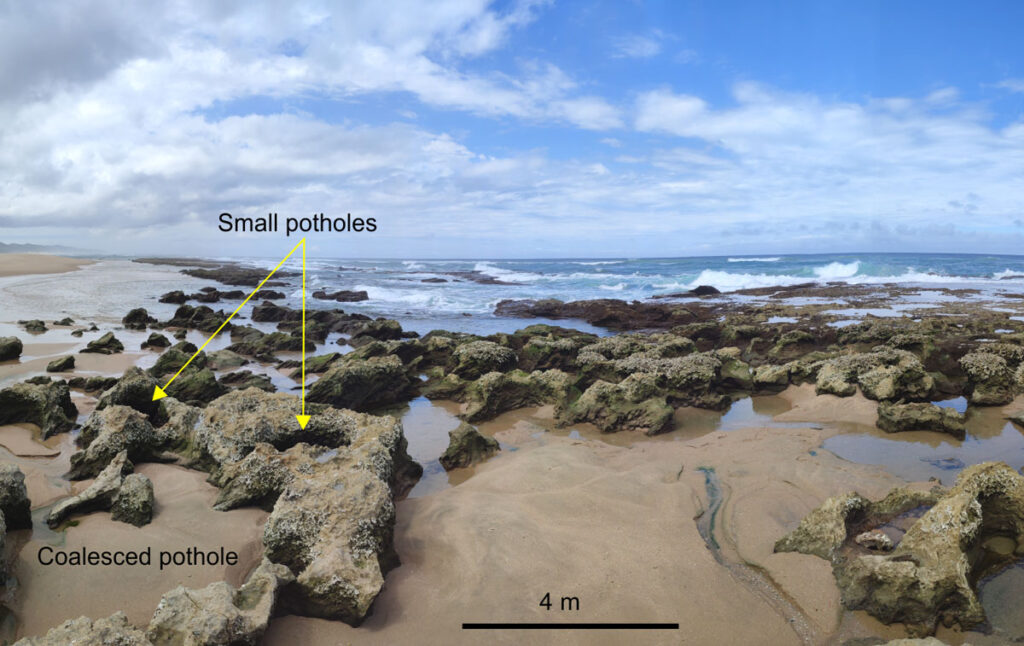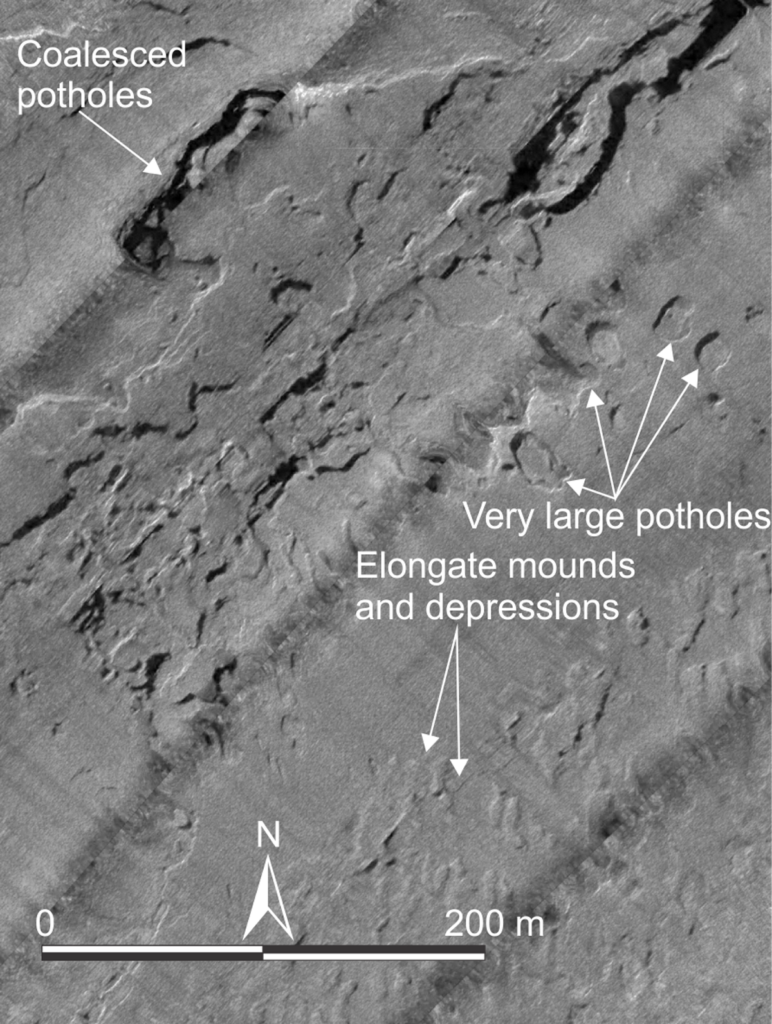South Africa’s coast is renowned for mighty waves and world-class surfing. Those same breaks might have carved the world’s largest marine potholes.
Researchers recently discovered a cluster of large depressions on the seafloor 90 meters (300 feet) below the ocean surface off the coast of Eastern Cape Province. That’s far deeper than similar features, said Andrew Green, a marine geologist at the University of KwaZulu-Natal in South Africa and lead author of a new study published in Geomorphology.

Green and his colleagues believe the formations are marine potholes, circular depressions drilled into bedrock by grinding sediments. Potholes can form anywhere water swirls stones against bedrock, from river eddies to rainy hillsides.
In intertidal zones, constant waves send sediments corkscrewing. That phenomenon can result in a landscape pocked by small, grooved bowls. Most observed marine potholes are found no deeper than 50 meters below the surface—shallow enough for a scuba diver to visit, Green said. The Eastern Cape potholes sit on a seafloor almost twice as deep. Once a site of crashing waves, the location would have been submerged as rising sea levels shifted the intertidal zone inland. The potholes may therefore reveal the location of an ancient seashore.
That is, if the pits are even potholes at all. Their depth is just one of the cluster’s curiosities. Marine potholes rarely exceed 2 meters in diameter, but these depressions stretch up to 60 meters (200 feet) across. Compared to marine potholes in China, Hawaii, and Japan, Green said, “these things are orders of magnitude bigger.” They are also unusually shallow: Their diameter-to-depth ratio is 50:1, whereas most potholes have a ratio around 2:1.
Stumbling on the Scene

Green first found the holes while working with developers looking to anchor an underwater energy farm within the shelf’s fast-moving current. An initial survey of the seafloor turned up a string of depressions. Instead of being buried under a thick layer of sediment, as expected at the ocean bottom, the bedrock features were completely uncovered.
The holes were generally symmetrical, leading Green to suspect they might be supersized potholes. He returned with a research vessel equipped with bathymetry and sonar devices to paint a 3D portrait of the seafloor and identify the bedrock material beneath the pits. To verify their maps, the researchers sent submersibles to collect photographs and seafloor samples. In total, the mapping revealed 238 holes on the Eastern Cape shelf.
Examining the Clues
Green and his colleagues estimate the potholes formed about 14,500 years ago, as Earth transitioned from an ice age to a period called the Bølling-Allerød warming. The ice age was the last time sea levels were low enough for long enough to expose the location to waves.
The holes tend to form in bands that align with natural layers in the bedrock, which is made of aeolianite, a rock formed from hardened sand dunes. The researchers suggest that when the area was above sea level, sea spray may have pooled on the aeolianite and chemically dissolved weaker layers of the rock, similar to the way rainwater dissolves limestone to create sinkholes. Later, as sea level climbed, waves swirled small rocks into the shallow striations and eventually carved out massive circles.
Pothole size is limited by time and climate, Green said. The larger the pothole is, the longer the bedrock was exposed to waves and weathering. The Bølling-Allerød warming period was wet and warm—prime conditions for chemical weathering—and lasted long enough to satisfy the sea spray hypothesis.
“I think that is the most important mechanism that created that kind of irregularity.”
But many details are missing. Stones that carve potholes typically end up stuck inside the hole they created. Nearby potholes on the KwaZulu-Natal shelf closer to the shore are full of grinding stones, the researchers noted. None of the 238 Eastern Cape potholes have grinding stones.
The theory proposed in the paper is questionable, said Balai Chandra Das, a geomorphologist at Krishnagar Government College in India. Depressions need a critical depth-to-diameter ratio to trap grinding stones, he said. The Eastern Cape potholes are too shallow and too large to trap much or even sustain the vortex needed to spin sediments. Any grinding stones would have likely washed away, rather than get caught in an abrasive spiral.
“Obviously, there is some chemical weathering,” Das said. “I think that is the most important mechanism that created that kind of irregularity.”
Green and his colleagues recognize these anomalies need further study. The survey was a first attempt to explain these unique formations by mapping the seafloor. Green said he hopes to collect more seafloor samples to date when the formation submerged. For now, the mystery remains.
—J. Besl (@J_Besl), Science Writer

